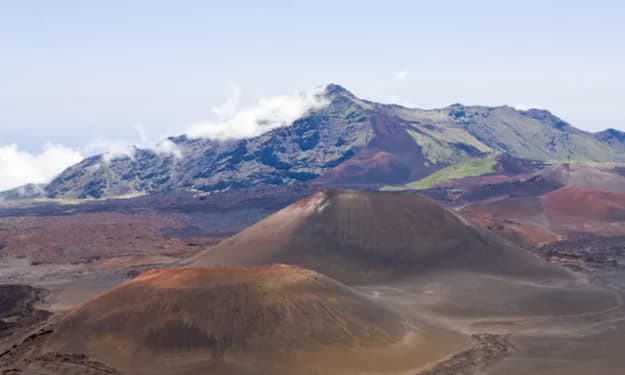Content warning
This story may contain sensitive material or discuss topics that some readers may find distressing. Reader discretion is advised. The views and opinions expressed in this story are those of the author and do not necessarily reflect the official policy or position of Vocal.
The Resilience of Life: Surviving Ancient Super Volcanoes
Nature's Unyielding Spirit: A Journey Through Ancient Super Volcanoes and the Resilience of Life

Introduction:
Millions of years ago, the American landscape bore witness to an extraordinary geological phenomenon - the "ignimbrite flare-up," a series of super volcanic eruptions that shaped the course of history. These catastrophic events unleashed unimaginable power, dwarfing even the colossal eruption of Yellowstone. Surprisingly, these massive eruptions occurred relatively frequently, approximately every 10,000 years, engulfing North America in a thick layer of ash. However, life endured and thrived, leaving behind a remarkable fossil record. In this blog, we will delve into the astonishing resilience of ancient creatures and plants, exploring how they not only survived but also bounced back to shape the present-day world.
Unleashing the Ancient Fury:
Approximately 28 million years ago, in ancient Colorado, the Earth witnessed an event of unimaginable magnitude - a super volcanic eruption. The eruption expelled superheated ash and pumice, creating a colossal caldera over eight times the size of present-day Denver. The fiery ash clouds blotted the landscape, resulting in thick deposits of ignimbrite, appropriately named "storm cloud of fire" in Latin. The most prominent ignimbrite from this era is "The Fish Canyon Tuff," recording an eruption that exceeded the magnitude of even Yellowstone's most massive eruption by nearly 5,000 times, dwarfing the 1980 Mount St. Helens eruption.
The Astonishing Ignimbrite Flare-Up:
The ignimbrite flare-up, an era spanning from around 36 million to 18 million years ago, saw a remarkable proliferation of super volcanic eruptions across North America. Geologists have identified over 230 eruptions, with at least 25 of them being super volcanic in scale. These eruptions unleashed a staggering amount of material, capable of covering the entire United States in ash deposits more than 55 meters deep. Despite the magnitude of these eruptions, remarkably, no catastrophic mass extinctions occurred. Ecosystems exhibited incredible resilience and adapted to the extreme conditions.
A Terrifying Past, A Resilient Present:
To understand how life endured such violent events, we must delve into the geological processes behind the ignimbrite flare-up. The movement of the Pacific Plate beneath the North American continental plate caused the ancient Farallon Plate to collide with the continent, giving rise to the magnificent Rocky Mountains. As the Farallon Plate eventually sank, magma surged in to fill the gaps. However, the thick continental crust impeded the magma's ascent, creating highly explosive and perilous eruptions due to the magma's high silica content.
How Ancient Animals Survived Volcanic Eruptions:
Despite the devastation wrought by the ignimbrite flare-up, numerous animals evolved ingenious strategies to survive the cataclysmic eruptions. Burrowing creatures like pocket gophers and Western toads sought refuge in their underground burrows during eruptions, emerging safely after the ash had cooled. Aquatic animals took shelter in lakes, skillfully avoiding falling debris and staying protected beneath the ice. Larger animals near eruption sites endured initial impacts, yet their wider distribution ranges and rapid ecosystem recovery allowed for their survival.
Ecosystem Recovery: Nature's Resilient Dance:
One of the most astounding aspects of the ignimbrite flare-up was the swift recovery of ecosystems. Unlike lava, which leaves barren landscapes in its wake, ash deposits fostered plant growth by creating nutrient-rich soils and retaining moisture. This allowed plants to thrive, rapidly recolonizing the landscape. Animals followed suit, adapting to the changed environment and forging ahead against remarkable odds. Even after the most massive eruptions, life bounced back, showcasing its incredible resilience.
Conclusion:
The ignimbrite flare-up was an epoch of tumultuous geological activity that could have spelled catastrophe for life on Earth. Yet, the astonishing resilience of nature prevailed, allowing ecosystems to recover swiftly and thrive despite the extraordinary challenges. The fossil record preserved within the ignimbrite deposits stands as a testament to the tenacity of life, offering invaluable insights into the past and invaluable lessons for the future. As we marvel at the majesty of the Earth's geological history, let us also admire the enduring dance of life, forever adapting to and overcoming the adversities it encounters. Nature's resilience remains an inspiration and a beacon of hope as we navigate the ever-changing world around us.
About the Creator
Rohit Singh
Software developer, part-time content creator, and tech enthusiast.
Unleashing creativity and embracing tech. Join me on this thrilling journey! 🚀






Comments
There are no comments for this story
Be the first to respond and start the conversation.